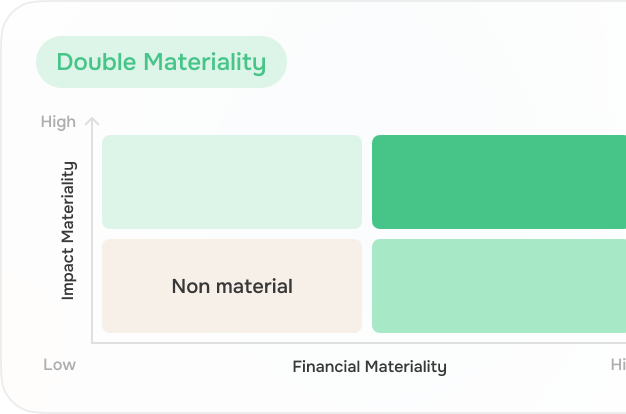The Materiality
assessment is made mandatory by the CSRD
Bald müssen ca. 50.000 Unternehmen Nachhaltigkeitsberichte vorlegen, gemäß der Corporate Sustainability Reporting Directive (CSRD).
Eine Wesentlichkeitsanalyse nach CSRD-Vorgaben ist nötig, um relevante Themen für Berichterstattung und Nachhaltigkeitsmanagement zu bestimmen. Details dazu finden Sie auf dieser Seite.

Why a materiality assessment?
Comply with legal requirements
Find priorities of the company
Identify own value drivers
How is a CSRD materiality assessment performed?
The doppelte Wesentlichkeitsanalyse stellt den Ausgangspunkt der CSRD-konformen Berichterstattung und des strategischen Nachhaltigkeitsmanagements dar. Damit wird sie für betroffene Unternehmen zur Pflicht. Die doppelte Wesentlichkeitsanalyse lässt sich mit den folgenden Schritten durchführen.
Status quo analysis | Creation of the longlist | Stakeholder involvement | Impact & financial perspective | Consolidation to the shortlist |
|---|---|---|---|---|
Definition of company profile | Identification of potentially material topics | Identification and selection of key stakeholders | Structured analysis of the company's material impact | Presentation of material topics on materiality matrix |
Visualization of the value chain | Involvement of key stakeholders | Involvement of key stakeholders | Shortening of longlist to shortlist | |
Status quo overview | Documentation of the process and results |
Was muss jetzt getan werden?
For many companies, there is not much time left, um die Prozesse aufzusetzen, mit denen die Anforderungen einer Nachhaltigkeitsberichterstattung nach der CSRD in a timely and efficient manner. umgesetzt werden können. Gleichzeitig sind Ressourcen und Kapazitäten häufig knapp, und die Erfahrung sowie das Wissen über die Anforderungen einer CSRD-konformen Wesentlichkeitsanalyse sind oft sehr begrenzt. Wir bieten daher unsere Unterstützung bei der Durchführung einer doppelten Wesentlichkeitsanalyse sowie der anschließenden Datenerfassung an.
Start the CSRD materiality assessment
Eine CSRD konforme Wesentlichkeitsanalyse durchzuführen ist zeitaufwendig, methodisch vielfältig und komplex. Daher unterstützen wir Unternehmen dabei und steuern sie durch den gesamten Prozess. Auf unserer Plattform können Sie mit Hilfe unserer Expert:innen die Analyse effizient umsetzen und zuverlässige Ergebnisse liefern. Melden Sie sich bei uns, um mehr zu erfahren.
Collect data for sustainability report
Sie möchten direkt mit der Datenerfassung starten, haben aber kaum Ressourcen? Dann lassen Sie uns einfach mit der WeShyft Software die Datenerfassung beginnen und steuern. So schaffen Sie es schnell, die wesentlichen Daten an einem Ort zu sichern, können Ihre Nachhaltigkeitsperformance überblicken und in ansprechende Grafiken übersetzen. Melden Sie sich bei uns, um mehr zu erfahren.
Further information
Wir bieten Ihnen eine Vielzahl an weiteren Wissensressourcen, um sich tiefer in das Thema CSRD-konforme Wesentlichkeitsanalyse einzuarbeiten. Eine Auswahl der wichtigsten Inhalte finden Sie hier:

Webinar: Do’s & Don'ts der doppelten Wesentlichkeitsanalyse
Die Anforderungen der Corporate Sustainability Reporting Directive (CSRD) und die Umsetzung der doppelten Wesentlichkeitsanalyse stellen Unternehmen vor zahlreiche Herausforderungen. Ein Jahr nach Einführung der Wesentlichkeitsanalysen ist es an der Zeit, Bilanz zu ziehen: Welche Herausforderungen sind aufgetreten und wie können diese erfolgreich gemeistert werden? Und welche Ansätze gibt es für eine erfolgreiche Wesentlichkeitsanalyse?

Webinar: Die Wesentlichkeitsanalyse: Ab-grenzung & Umsetzung im Rahmen der ESRS
Welche Themen müssen berücksichtigt werden in einem Nachhaltigkeitsreport und welche nicht? Um diese Fragen zu beantworten, gibt es die Wesentlichkeitsanalyse. Nur leider gibt es nicht das EINE Verständnis von Wesentlichkeit, sondern verschiedene, die beeinflussen, wie Unternehmen relevante Themen für ihren Bericht identifizieren. Wir stellen die verschiedenen Ansätze vor und wagen einen Deep Dive in die CSRD konforme Wesentlichkeitsanalyse.